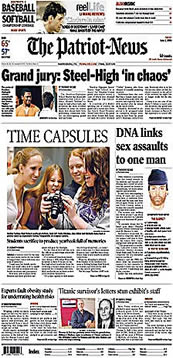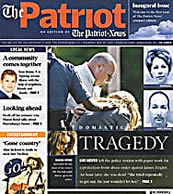
| Fit To Print |
 |
followthemedia.com - a knowledge base for media professionals |
|
|
AGENDA
|
||
Newspapers Can Attract Back the Young, But They Must Take Steps Not to Offend Older ReadersSome very recent research projects suggest that newspapers can regain their lost young readers, if not to the newspaper itself, then at least to special web sites set up to attract just that desired 18-30 readership age.
|
| ftm background |
|
New York Times Tries Something New: If the Young Wonít Read Its Newspaper, Then Buy Into the One They Do How to Maintain Readership Loyalty The Young Choose the Internet for Information, Television for Entertainment and Newspapers For ÖWell, Actually They Donít Choose Newspapers Hardly At All News Agencies Need to Re-Examine Their News Production Survival for some French Dailies in Doubt |
Beep, a short project run by Northwestern University’s Medill school of Journalism in conjunction with the Daily Herald in suburban Chicago, found that if a newspaper established a special web site for the younger reader, concentrating on weblogs written by young journalists about entertainment and lifestyle then that would draw a young local audience.
Add to that site cross promotion to stories in the print edition or links to headlines on the newspaper’s normal web and it draws the young to the main newspaper products. And since the young are attracted more to a newspaper’s web site than they are to print it is important for the newspaper’s main web site to cross promote heavily the younger reader site.
Since the young are particularly fond of weblogs on subjects they most identify with, then maintaining a directory of such local area blogs on the young newspaper reader’s web site will attract even more readership, and encouraging those external blog sites to place links to the young reader’s newspaper site is like gold dust.
It’s the same type of thinking behind a new web site in Spain, run by El Pais, aimed at the 18+ readers. Completely different from the look and feel of the newspaper and the regular El Pais web site, EP3 focuses on sex, music, movies, vacations, loads of pictures, chats with specialists from various fields of interest to the young, and encouraging the young to communicate to it via their mobile phones..
Also trying something new to latch onto the 18+ reader is the New York Times Company that paid in January $16.5 million for a 49% share of Metro Boston with the aim of helping its Boston Globe unit recover lost young readership.
The Times’ New England Media Group and Metro Boston are launching Boston Uncovered, a print magazine with its own web presence on the Globe’s Internet site, aimed directly at students on the more than 50 college campuses in the Boston area. The magazine aims to tell just about everything a young college student would want to know about life in Boston, with some of the articles written by local students.
The magazine is being heavily promoted to advertisers as the ideal vehicle to reach that 18+ age group. Boston Metro will feature a weekly feature on the magazine’s content. Frequent updates will be posted on the web site.
In another experiment on a much smaller scale, the Hayward Daily Review in California offers high school students a column in the newspaper each Monday. It’s a cheap investment at $25 a column, but the subject matter should engage student peers and it could extend to more columns, and it is yet another way of encouraging the young to stay with the newspaper.
Another fascinating project by Northwestern University, this time by its Readership Institute in the Media Management Center in conjunction with the Minneapolis Star-Tribune, says that the way news and advertising is presented has a direct affect on the success of reaching the desired group.
The study showed that younger readers are most interested in stories that have a “talk about it” appeal. In other words the story should leave such an impression that it is talked about with friend, family, workmate etc. The story also needs to speak to the concerns and interests of the young, reflecting their perspectives, and if a story is somewhat routine a bit of humor doesn’t hurt.
That is all a bit easier said than done, according to team leader Nancy Barnes. “Newspapers tend to talk about topics, keeping a distance between themselves, the topic and the reader. In this experiment we actively sought to talk to readers directly, and engage them in every step along the way. That makes the newspaper seem more personal. It also goes against our natural instincts, however.”
Among the techniques that found favor with the young were choosing subjects of most interest to the group (nothing new in that) but also stories that play to the many experiences the young share. Use active headlines, write stories in the manner of “why this applies to you”, and make the stories less wordy.
One unanswered question from the research that was aimed at young readers was how would the older reader react to such approaches. The report says it all needs to be tested on the older reader but, “whether 21 or 61, readers are motivated to read when a newspaper purposely works to ‘make me smarter,’ ‘look out for my interests’, or ‘gives me something to talk about.’ But it’s reasonable to expect that some content choices and framing may differ according to age.”
And those same principles seem to apply, also, to advertising. Ads that give “something to talk about” and seem to look after the user’s best interests found the most favor among the young. Something for Madison Avenue to play with!
Perhaps the most interesting experiment of all started in May when the Patriot-News in Harrisburg, Pennsylvania, began publishing a compact edition of its newspaper in addition to the broadsheet.


Publisher John Kirkpatrick said the newspaper wanted to really attract the young reader – especially the young woman reader who seems to have less time than any other group to read the newspaper. And focus groups indicated that every time a change was made to the broadsheet newspaper to satisfy reaching the young it alienated older readers.
The solution, therefore, was to print two newspapers – broadsheet and compact (tabloid still is a dirty word in the US) and each is deliverable to its subscriber via home delivery by 6 a.m. or at the newsstand. Focus groups again indicated that a newsstand sale only wouldn’t work for the compact; it had to be delivered to the front door.
The compact prints less than 10,000 copies daily whereas the broadsheet prints more than 100,000, but the experiment is still young and advertisers seemingly are just as interested in seeing how everything turns out and are being very helpful in overcoming such problems as the right ads for each size newspaper and the rates for each.
The compact features only the main local and national news, the stories are written shorter with no jump pages, and the pictures and graphics are larger – in other words a quick read for a busy reader.
While the London Times and the Independent both printed broadsheet and compact for a year or more before killing off their broadsheets, Kirkpatrick said there is no such intent to kill the broadsheet in Harrisburg. It’s an experiment that merits watching.
And even the venerable Associated Press is getting in on the youth act. It plans to launch on September 19 a new service called asap aimed at younger readers. The idea is great, but it is interesting that the editor of the service is 37, and the ages of the other editors just appointed are 28, 30, 32, 36, and 40. They are depending on AP staff to point them in the right direction for stories of interest to the young.
No doubt all are very capable news agency journalists and editors, and not even wanting to go near an age discrimination debate, the pragmatic question is whether that thirty something age grouping can really talk the talk, know the real interests, and satisfy the knowledge needs of the younger generation, presenting everything in a such a way that the young can identify.
The AP could do worse than steal a page from a successful French operation, Group Play-Bac Presse. It prints three successful national French daily newspapers aimed at the 7 – 13 year-olds – obviously a younger audience than the AP is going after but the concept on how to achieve the goal remains the same. Those French youth newspapers are more successful financially than the nine other general interest national French newspapers.
A prime reason for such success is how stories are chosen -- twice a week children, aged 10 – 14 from around France are invited to participate in three-hour editorial meetings. They act as the editor-in-chief and section editors, picking the stories, and their ranking. Adults write the actual stories. Even if the adults think the stories chosen are wrong, they still abide by the children’s decisions, the thinking being that maybe kids have a better idea what other kids want to read than adults. And most important, while the adults do the writing the kids tell the adults what they believe are the most important points to include in the stories.
That formula seems to work. The three papers sell some 200,000 copies on a subscription basis only. Parents read it, including some who do not subscribe to any other newspaper, according to founder and editor-in-chief Francois DuFour.
At the very least this would point to a youth advisory board of 18+ ages being of great help to AP asap editors in deciding what the 18+ reader is most interested in, and more importantly boiling down each topic into what would be of most interest – the “talk about” feature of the story -- and then the AP goes and writes the stories based on that knowledge.
Even better, one could visualize AP youth advisory boards eventually in every state – set up with the help of their members—yet another way for the member to get involved with that age demographic -- for surely this project has to go beyond a national level; it must extend to the local (state) level, too.
My own son is right in the middle of that desired age demographic. He’s on the Internet a whole lot and hardly reads a newspaper except occasionally the sports section or to find out what time a movie starts. So it was in that environment a few years ago that I mentioned to him how I preferred watching old black and white movies because they told real stories and that Cary Grant was probably my favorite actor.
“Cary Who?” That comment spoke volumes, and it was the end of that conversation. It’s a lesson we “old-timers” must take to heart.
The compact Patriot is no more.
After just a few months Publisher John Kirkpatrick said the compact, with a circulation around 10,000, just did not draw in the additional readers he had hoped for. Itís a rare victory for a broadsheet over a compact.
Kirkpatrick did say people reacted well to the additional color found in the compact as well as some other features and those will be incorporated into the 100,000 + circulation Patriot-News.
| copyright ©2005 ftm publishing, unless otherwise noted | Contact Us • Sponsor ftm |